Gayle Chong Kwan interrogates legacies of extraction and exploitation and histories of oppression in her expanded and embodied art practice, using sensory experience, material objects and collective ritual to reflect on the past and envisage alternative futures. In A Pocket Full of Sand, now at John Hansard Gallery in Southampton, themes of colonial power, indentured labour, leisure and childhood meander and crisscross through the mediums of film, sculpture and collage.
Unexpected, fruitful connections are drawn out between two islands at opposite ends of the British empire: the Isle of Wight and Mauritius, the birthplace of Chong Kwan’s father. The London-based artist homes in on the materiality of sand and sugar, the mainstay of Mauritius’s colonial economy, harvested initially by enslaved people, and subsequently by indentured workers. “By thinking about colonial time and contemporary time, it positions different moments within connections that are always there. It just takes that kind of material engagement or archival research or creative conjecture, to make those linkages,” says Chong Kwan.
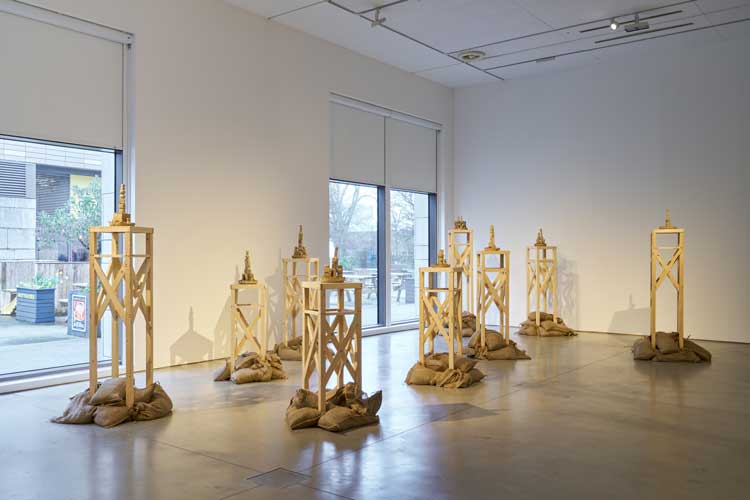
Gayle Chong Kwan: A Pocket Full of Sand, installation view, John Hansard Gallery, Southampton, 10 February – 1 May 2024. Photo: Reece Straw.
Entering the show, the visitor is confronted by a series of wooden structures, which serve as plinths for teetering beige totems reminiscent of children’s building blocks. These small-scale sculptures look innocuous, yet the shadows cast by the plinths, which are ballasted by sandbags, evoke watchtowers. Moreover, the blocks are made from bagasse, a waste product of sugar cane, muddying the suggestion of child’s play with the politics of sugar production. The tension between play and (geo)politics is made more explicit in Chong Kwan’s titular moving image work, A Pocket Full of Sand, which takes as its starting point two pieces of archival footage – a 1950s tourism film for the Isle of Wight and a film from the 1940s of indentured sugar cane workers in Mauritius, who arrived there after slavery was abolished.
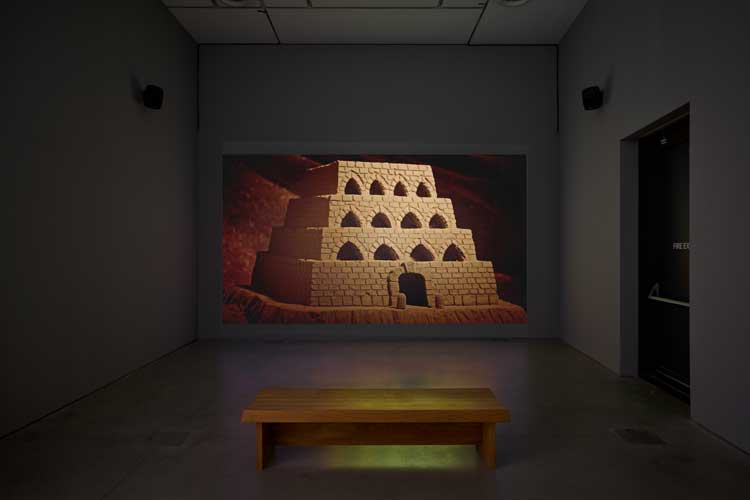
Gayle Chong Kwan: A Pocket Full of Sand, installation view, John Hansard Gallery, Southampton, 10 February – 1 May 2024. Photo: Reece Straw.
Chong Kwan juxtaposes two scenes repeatedly: in one, a British boy smuggles lumps of sugar from teatime into his pocket to feed to a donkey that is pulling a water wheel at Carisbrooke Castle; in the other, a boy of similar age toils barefoot on a plantation cutting sugar cane under British colonial rule. These archival scenes are interspersed with shots of amplified versions of forbidding colonial architecture in Mauritius, that retain the trappings of authority – note for instance the royal insignia “VR” for Victoria Regina and the sign “Vagrants’ Depot”. Filmed from close up and at night, it is hard at first to tell the scale of these shadowy buildings which were instrumental in enforcing order in colonial times. Only near the end of the moving image work, when we observe one of these structures in the sea, does it become clear they are in fact elaborate and heightened sand recreations of the original buildings, diminished to the size of sandcastles. The camera shows the water gnawing away at this symbol of repression until eventually the last segment sinks under the waves.
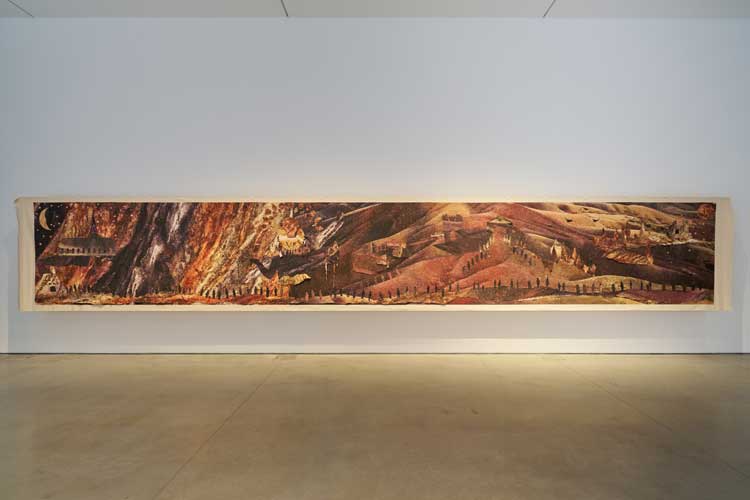
Gayle Chong Kwan: A Pocket Full of Sand, installation view, John Hansard Gallery, Southampton, 10 February – 1 May 2024. Photo: Reece Straw.
The artist reprises the motifs of sand, geology and colonialism in a vast digitally printed photographic collage, made of fraying textile fragments, that extends across an entire wall. In this rich panorama, the Isle of Wight’s famed rainbow sands of Alum Bay blend into the coloured sands of Mauritius, entwining the two sites in a geological kinship stretching back into deep time. Against this backdrop, images swim to the surface and recede: shells, skulls, boats, birds, colonial buildings, Carisbrooke Castle, an army of silhouettes that might be indentured workers or belong to the East India Company and maps of Rwanda in reference to the UK government’s controversial plans to deport immigrants there.
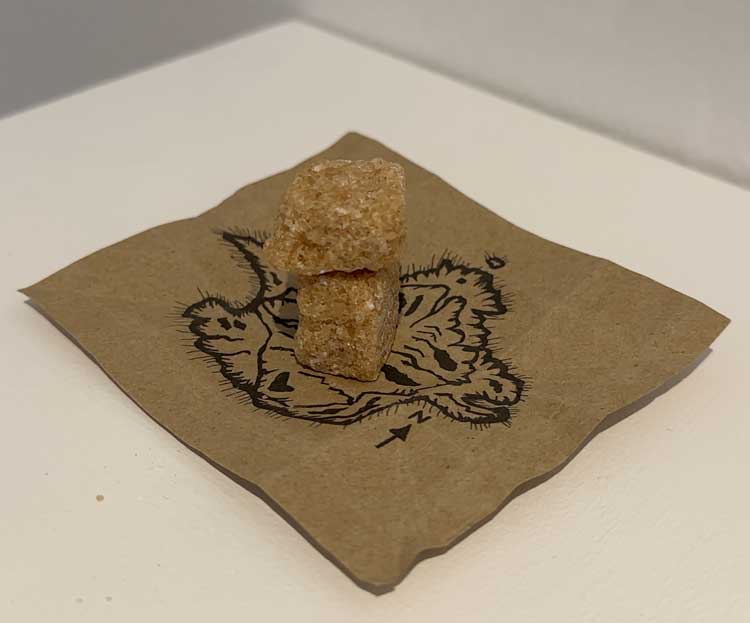
Gayle Chong Kwan: A Pocket Full of Sand, installation view, John Hansard Gallery, Southampton, 10 February – 1 May 2024. Photo: Martin Kennedy.
Chong Kwan’s practice navigates between forward and backward movements in time and space, between interior and exterior perspectives and between the individual and the collective. Indeed, the central premise of her PhD, recently awarded by the Royal College of Art, is “Imaginal Travel: political and ecological positioning as fine art practice”. And in this show, Chong Kwan invites us to undertake an imaginal journey involving our senses. Easily missable due to its minute scale, on a tiny shelf, two sugar cubes sit atop a treasure map as sugar wrapper, made from the outlines of Mauritius amalgamated with the Isle of Wight. Below and to the side stands a mound of sugar cubes from Mauritius, which visitors may ingest as they wander round the show contemplating the geographical and temporal passage of this sweet matter that is also a valuable economic commodity and is implicated in extractive and exploitative labour. “A lot of my work is this movement between very close up and far away, relating to that notion or methodology of ‘imaginal travel’ where you’re inviting the viewer to enter into the work and also to complete it collectively,” says Chong Kwan. “Things are revealed, but they are also hidden.”
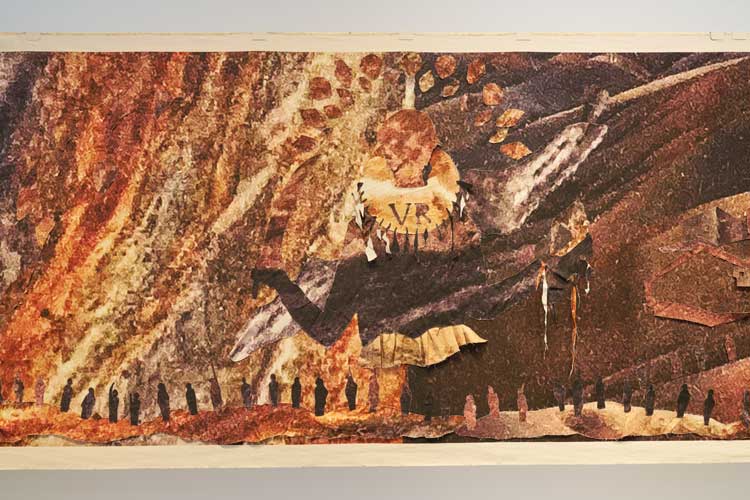
Gayle Chong Kwan: A Pocket Full of Sand, installation view, John Hansard Gallery, Southampton, 10 February – 1 May 2024. Photo: Reece Straw.
The artist will have a second exhibition, The Taotie, at Compton Verney, opening in March, further exploring notions of ritual, ancestry and diasporic histories. Inspired by the taotie, a mythological Chinese creature associated with gluttony and evil as well as with protection, the show will comprise photographic shrines, masks, bronze and clay offerings, and an annual ritual, presented alongside Compton Verney’s collection of Chinese funeral Neolithic bronzes.
Chong Kwan (b1973, UK) is an award-winning multidisciplinary artist. Exhibitions include: The Circulating Department, V&A Museum (2021); Wastescape, Auckland Arts Festival, New Zealand (2019); The People’s Forest, William Morris Gallery (2018); The Fairlop Oak, Barbican; Anthropo-scene, Bloomberg Space (2015); The Obsidian Isle, New Forest Pavilion, 2011 Venice Biennale; Cockaigne, Tales from the New World, 2009 Havana Biennial, Cuba. She won the Sustainable Art Prize in 2019.
Gayle Chong Kwan: A Pocket Full of Sand
John Hansard Gallery, University of Southampton
10 February – 11 May 2024
The Taotie
Compton Verney, Warwickshire
21 March 2024 – 31 March 2026
Interview by ELIZABETH FULLERTON
Filmed by MARTIN KENNEDY